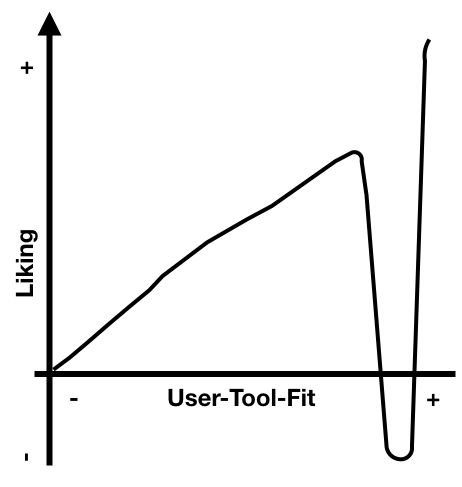Have no fear of perfection –
you’ll never reach it.
Salvador Dali
I recently did an online presentation on academic writing. During the Q&A, a student did ask for the best literature manager. He wasn’t satisfied with the ones he had tested, and he had tested a few. Somehow, each app had some issue that made it only almost right, but not right. At least I think that was the issue.
Looking at the issue, it’s another example of the uncanny valley of a user-tool-fit. According to the original uncanny valley, when you make something more human like, peoples’ affinity to it doesn’t go up in a linear fashion. Instead, it rises up to a certain point, only to drop sharply, and then rise again. (Think of the “Mass Effect: Andromeda” character models for an example of where the drop is. SCNR.)
There are issues with this model, but you get the same effect for a user-tool-fit. When you use this fit (or a subjective “closeness to perfection”) on the x-axis and affinity on the y-axis, you get the same uncanny valley. In the area of 0 to 80% perfection, the affinity to the tool increases. It gets more useful to you, to your ideal of the perfect software, so you like it more. But then there is this uncanny valley. Once it gets very close to perfection, the affinity drops sharply. Instead of liking it more, the now slight difference becomes so annoying that your affinity to the software craters.

In a way, it’s much more easy to work with a software that is 70-80% right than with a software that is 90 to 95% right. It’s a bit like Schwartz’ “Paradox of Choice” (“with all the options, there has to be a perfect fit for me”). Here it’s: “the app is so close to perfect, there has to be that option somewhere to close that final gap”.
Only there never is.
After all, for perfection both the world and the person have to be unchanging. (Not a happy thought.) Or the world and person have to be perfectly attuned in change. (Not a likely thought.)
My recommendation is: Take a software that is less close to perfect. Something in the 70 to 80% range. Something you can work with, something that does the job. Without annoying you by the tiny part that could be different to make it perfect.
After all, it’s only a tool. Nothing more, nothing less.
(P.S.: I might have already written about this topic, and I’m pretty sure it isn’t new. Still, something to keep in mind.)